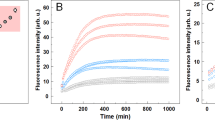Abstract
Amyloidogenesis of prion protein (PrP) is closely associated with the pathobiology of prion diseases. To understand details on formation of PrP amyloids, we investigated various conditions that influence the process in vitro, using full length and truncated recombinant PrP. Disrupted agitation and fluctuated temperature resulted in prolongation of lag phase during PrP amyloid formation. With the same conditions and material for the assay, fluorescence microplate readers of different manufacturers, which are assumed to have incongruent level of mechanical performance, demonstrated variations for the length of lag phase and the level of fluorescence detection. Presence of preformed amyloid seeds accelerated PrP amyloid formation. Similarly, recombinant proteins of different species affected effectual generation of amyloids. This process was also influenced by the concentrations and truncation of recombinant PrP. By investigating several conditions to perform PrP amyloid formation assay, our study addresses the factors that determine how much and how rapidly PrP amyloids are formed.









Similar content being viewed by others
Abbreviations
- Gdn-HCl:
-
Guanidine hydrochloride
- MoPrP:
-
Mouse prion protein
- PrP:
-
Prion protein
- PrPC :
-
Cellular prion protein
- PrPSc :
-
Scrapie prion protein
- PAFA:
-
PrP amyloid formation assay
- PBS:
-
Phosphate-buffered saline
- SDS-PAGE:
-
Sodium dodecyl sulfate-polyacrylamide gel electrophoresis
- SHaPrP:
-
Syrian hamster prion protein
- TEM:
-
Transmission electron microscopy
- ThT:
-
Thioflavin T
References
Prusiner SB (1998) Prions. Proc Natl Acad Sci USA 95:13363–13383
Ryou C (2007) Prions and prion diseases: fundamentals and mechanistic details. J Microbiol Biotechnol 17(7):1059–1070
Novitskaya V, Bocharova OV, Bronstein I, Baskakov IV (2006) Amyloid fibrils of mammalian prion protein are highly toxic to cultured cells and primary neurons. J Biol Chem 281(19):13828–13836
Corsaro A, Thellung S, Villa V, Nizzari M, Florio T (2012) Role of prion protein aggregation in neurotoxicity. Int J Mol Sci 13(7):8648–8669
Bucciantini M, Nosi D, Forzan M, Russo E, Calamai M, Pieri L, Formigli L, Quercioli F, Soria S, Pavone F, Savistchenko J, Melki R, Stefani M (2012) Toxic effects of amyloid fibrils on cell membranes: the importance of ganglioside GM1. FASEB J 26(2):818–831. doi:10.1096/fj.11-189381
Caughey B, Baron GS, Chesebro B, Jeffrey M (2009) Getting a grip on prions: oligomers, amyloids, and pathological membrane interactions. Ann Rev Biochem 78(1):177–204
Ghetti B, Dlouhy SR, Giaccone G, Bugiani O, Frangione B, Farlow MR, Tagliavini F (1995) Gerstmann-Strässler-Scheinker disease and the Indiana kindred. Brain Pathol 5:61–75
Piccardo P, Manson JC, King D, Ghetti B, Barron RM (2007) Accumulation of prion protein in the brain that is not associated with transmissible disease. Proc Natl Acad Sci USA 104(11):4712–4717
Sim VL, Caughey B (2009) Ultrastructures and strain comparison of under-glycosylated scrapie prion fibrils. Neurobiol Aging 30(12):2031–2042
Wille H, Michelitsch MD, Guenebaut V, Supattapone S, Serban A, Cohen FE, Agard DA, Prusiner SB (2002) Structural studies of the scrapie prion protein by electron crystallography. Proc Natl Acad Sci USA 99:3563–3568
Govaerts C, Wille H, Prusiner SB, Cohen FE (2004) Evidence for assembly of prions with left-handed b-helices into trimers. Proc Natl Acad Sci USA 101:8342–8347
DeMarco ML, Silveira J, Caughey B, Daggett V (2006) Structural properties of prion protein protofibrils and fibrils: an experimental assessment of atomic models. Biochemistry 45(51):15573–15582
Ryou C, Mays CE (2008) Prion propagation in vitro: are we there yet? Int J Mol Sci 5:347–353
Shin W, Lee B, Hong S, Ryou C, Kwon M (2008) Cloning and expression of a prion protein (PrP) gene from Korean bovine (Bos taurus coreanae) and production of rabbit anti-bovine PrP antibody. Biotechnol Lett 30(10):1705–1711
Ryou C, Prusiner SB, Legname G (2003) Cooperative binding of dominant-negative prion protein to kringle domains. J Mol Biol 329:323–333
Kang H-E, Weng CC, Saijo E, Saylor V, Bian J, Kim S, Ramos L, Angers R, Langenfeld K, Khaychuk V, Calvi C, Bartz J, Hunter N, Telling GC (2012) Characterization of conformation-dependent prion protein epitopes. J Biol Chem 287(44):37219–37232
Baskakov IV, Legname G, Baldwin MA, Prusiner SB, Cohen FE (2002) Pathway complexity of prion protein assembly into amyloid. J Biol Chem 277:21140–21148
Colby DW, Zhang Q, Wang S, Groth D, Legname G, Riesner D, Prusiner SB (2007) Prion detection by an amyloid seeding assay. Proc Natl Acad Sci 104(52):20914–20919
Halfmann R, Lindquist S (2008) Screening for amyloid aggregation by semi-denaturing detergent-agarose gel electrophoresis. J Vis Exp 17:e838
Herczenik E, Gebbink MFBG (2008) Molecular and cellular aspects of protein misfolding and disease. FASEB J 22(7):2115–2133
Dobson CM (2003) Protein folding and misfolding. Nature 426:884–890
Härd T, Lendel C (2012) Inhibition of amyloid formation. J Mol Biol 421(4–5):441–465
Cobb NJ, Apetri AC, Surewicz WK (2008) Prion protein amyloid formation under native-like conditions involves refolding of the C-terminal α-helical domain. J Biol Chem 283(50):34704–34711
McKinley MP, Meyer RK, Kenaga L, Rahbar F, Cotter R, Serban A, Prusiner SB (1991) Scrapie prion rod formation in vitro requires both detergent extraction and limited proteolysis. J Virol 65:1340–1351
Acknowledgments
This work was supported in part by Basic Science Research Program through the National Research Foundation of Korea funded by the Ministry of Education, Science and Technology (2012R1A1A2043356).
Conflict of interest
The authors declare that they have no conflict of interest.
Author information
Authors and Affiliations
Corresponding author
Additional information
Seon-Gu Kim and Hye-Mi Lee have contributed equally for this work.
Rights and permissions
About this article
Cite this article
Kim, SG., Lee, HM. & Ryou, C. Parameters that Affect Macromolecular Self-Assembly of Prion Protein. Protein J 33, 243–252 (2014). https://doi.org/10.1007/s10930-014-9556-z
Published:
Issue Date:
DOI: https://doi.org/10.1007/s10930-014-9556-z




